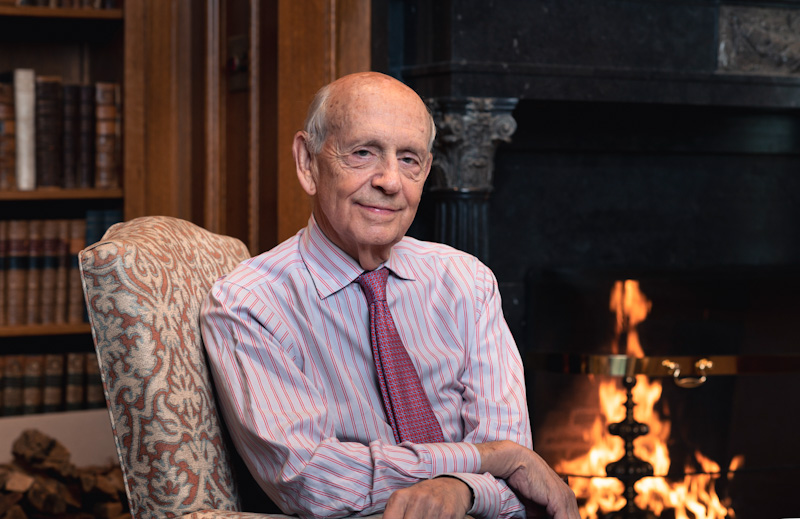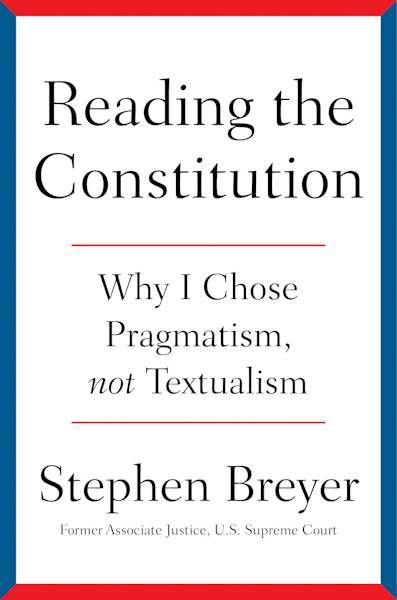Retired Justice Stephen Breyer discusses new book in interview with ABA Journal

Retired U.S. Supreme Court Justice Stephen Breyer in 2023. His new book, "Reading the Constitution: Why I Chose Pragmatism, Not Textualism," comes out Tuesday. (Collection of the Supreme Court of the United States)
“Textualism just doesn’t work very well,” Stephen Breyer tells me in a recent interview. The retired associate justice of the nation’s highest court is referring to interpreting statutes and the Constitution with heavy reliance on their words and phrases—including what they meant at the time drafted. This method has gained popularity within the Supreme Court’s marble edifice.
But the former jurist is hopeful that a long-term shift in this direction will be avoided. Textualism “doesn’t tell you the answer to a lot of problems,” he continues. “You have to look at other things.”
By this, Breyer means examining a law’s purpose and considering the consequences of a decision. He believes that “pragmatism,” as this method is called, is superior for deciding the court’s complex disputes.
“Someone wrote those words. What did they have in mind?” he asks. “Let’s see if we can find out. And once we find out, let’s see if we can’t use that fact to help interpret the words that are obscure, ambiguous or difficult to understand.”
“There are very few cases where just reading the words gives you the answer,” Breyer says. “If the words were so clear, why is the case in the Supreme Court? We almost always take cases where lower court judges have reached different conclusions as to the meaning or application of the same words.”
Breyer makes his case in Reading the Constitution: Why I Chose Pragmatism, Not Textualism, scheduled for release on Tuesday. He sums up his concern in the book’s opening pages: “And I fear the current enthusiasm for widespread adoption of more purely textual or linguistic approaches to interpretation means that other equally or more important tools will be set aside. It is as if an artist were to try to paint with only half a palette.”
The book’s conclusion is more specific. Breyer believes the current court should not take the textualist path and makes his case to some former colleagues.
Of course, the problem will all be solved, I suggest to Breyer, when the Supreme Court is eventually replaced with artificial intelligence. I’m half joking. But Breyer has in fact given the subject some thought.

A time for reflection
After 40-plus years as a judge, Breyer’s book is a logical capstone. “For better or for worse,” he tells me, “It might be helpful to put down my approach how I go about interpreting difficult phrases, the Constitution or statutes.”
Breyer knew his undertaking could offer a unique perspective on the interpretive divide. “Many scholars in law schools,” he says, “can write very well about how judges decided cases. But I have had some practice, and that’s an experience others haven’t necessarily had.”
He takes advantage of this perch by using carefully selected examples of his own linguistic skirmishes with former colleagues.
Breyer pulled off a remarkable feat with his new book—producing a work that is welcoming to a lay reader, while providing enough analysis, and rarely available personal insight, to seemingly satisfy the cravings of Supreme Court scholars and enthusiasts.
Breyer, 85, grew up in San Francisco. He was nominated to the U.S. Supreme Court by President Bill Clinton in 1994 and retired in 2022. Before that he served 14 years on the U.S. Court of Appeals for the 1st Circuit.
He points to his background as a source for his views on the law. His father served 40 years as a lawyer for the city’s board of education, and Breyer wears his father’s retirement watch. His mother participated in various civic organizations.
The would-be jurist was raised in a household, he says, where he “learned something about civic life and helping other people, which was not just words but how people lived.”

Making his case against textualism
While the title of Breyer’s new book suggests that textualism and pragmatism present justices with an either-or choice, “you use both,” he says. And his case illustrations demonstrate their overlap. His principal objection to textualism, he tells me, is people who say, “You should look only [at the text].”
Breyer by no means ignores text, a point he makes in his new title: “Of course, a judge must consult the text and understand the text as limiting or helping to explain the scope of the statutory phrase. But I have learned over and over again that text is but one interpretive tool among many.”
Using more considerations, he tells readers, is “more faithful to the desire of the Constitution’s framers to establish a workable framework for long lasting government.”
This, he says, was the dictate of John Marshall in the chief justice’s 1819 opinion in McCulloch v. Maryland. In McCulloch, Marshall was called upon to decide whether the Constitution granted Congress the power to establish a national bank.
Breyer identifies numerous purpose-oriented tools Marshall called upon to conclude that it did. “[W]e must never forget that it is a Constitution we are expounding” Marshall famously declared in his opinion. To Breyer, this is a Supreme Court founder’s pronouncement that the document must be one that is workable.
Searching for a law’s purpose, Breyer says, also leads to a more democratic result: “It helps the law itself work better for the people who have to live under it. … Congress, by and large, finds out what people want and then tries to enact statutes accordingly. People don’t know ‘textualism.’ They think in terms of purposes: ‘We need a law that does such and such. We shouldn’t have a law that does so and so.’”
Justice Antonin Scalia was a well-known proponent of textualism, and Breyer recounts their debate. “[Scalia] would say, if everyone followed the methods I follow, it would be too complicated, and you would never get to any agreements. … And I said, but if everyone used the methods you are advocating, we’ll have a Constitution nobody wants.”
“George Washington didn’t know about the internet,” Breyer recalls telling Scalia.
Breyer gives the textualists a voice in the marketplace of ideas, laying out in detail, and at length, many of their arguments. He then deconstructs each to demonstrate its fallibility.
Among other things, he speaks of the difficulty of understanding a word or phrase as it was used in the late 18th century or mid-19th century when the Constitution or an amendment was adopted. This is a form of textualism that is sometimes referred to as “originalism.”
He also points to the problem that stare decisis presents for textualists. Courts normally follow precedent. But Breyer tells me, “For a couple of hundred years, people hadn’t used textualism.”
So applying this new approach will require some nontextualist-based decisions to be overruled. Except “textualism doesn’t tell you what cases to overrule,” Breyer says dismissively. “Unless you are going to overrule every case.”
Breyer has much to say about the clash between stare decisis and textualism in his book’s dissection of Dobbs v. Jackson Women’s Health Organization (2022). Breyer was in the minority in the decision that overruled Roe.
Suggesting a path forward
Breyer’s work ends with a lengthy discussion of whether the Supreme Court is experiencing a “paradigm shift” to textualism. He argues both sides—and then offers this guidance to certain former colleagues:
“Major changes take time, and there are many years left for the newly appointed justices to decide whether they want to build the law using only textualism and originalism or instead taking advantage of all the methods I have described here. But in planning how they would like to change the interpretive system, they must think about what will work best for the court and for the country.”
Despite the growing impact of artificial intelligence, and its innumerable uses predicted by many, Breyer does not envision it helping the high court resolve its vexing issues. He looks back four-plus centuries to dispel any impact of this futuristic technology.
Paraphrasing Michel de Montaigne’s 1584 essay “On Experience,” Breyer says that the French philosopher taught us that “the human mind is too complicated to reduce to a single set of formulas. You cannot have a set of laws that will deal with all of the situations that human beings create in the ways they live. So don’t try.”
When he clerked for U.S. Supreme Court Justice Arthur Goldberg after graduating from Harvard Law School, Breyer learned a valuable lesson from his first boss: It is best to accept that appellate judging is a win some-lose some business.
“When we would lose a case,” Breyer recalls, “[Justice Goldberg] would say, ‘All right, we’ve lost. There’s nothing much we can do about that. What do you want me to do? Complain nonstop? No. Don’t complain. Go on and decide the next case, and maybe you’ll win.’ That was a pretty good philosophy, and I think I learned that from him.”

Randy Maniloff is an attorney at White and Williams in Philadelphia and an adjunct professor at the Temple University Beasley School of Law. He runs the website CoverageOpinions.info.



